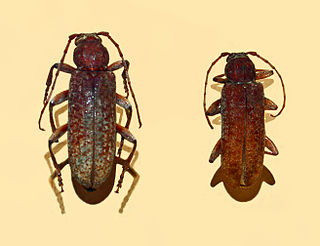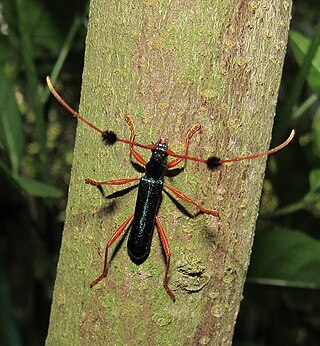
Cotyachryson is a genus in the longhorn beetle family Cerambycidae. There are at least three described species in Cotyachryson, found in Chile.

Achrysonini is a tribe of Long-Horned Beetles in the beetle family Cerambycidae. There are more than 20 genera and 50 described species in Achrysonini. They are found mainly in the Americas, but also in Europe, Asia, and Africa.

Abyarachryson is a genus in the longhorn beetle family Cerambycidae. This genus has a single species, Abyarachryson signaticolle, found in Chile.

Achryson is a genus in the longhorn beetle family Cerambycidae. There are about 17 described species in Achryson, found mainly in the Neotropics.
Cerdaia is a genus in the longhorn beetle family Cerambycidae. There are at least two described species in Cerdaia, found in Chile.
Drascalia is a genus in the longhorn beetle family Cerambycidae. This genus has a single species, Drascalia praelonga. It is found in Chile and Argentina.
Esseiachryson is a genus in the longhorn beetle family Cerambycidae. This genus has a single species, Esseiachryson minutum. It is found in Chile.

Geropa is a genus in the longhorn beetle family Cerambycidae. This genus has a single species, Geropa concolor. It is found in Mexico and the United States.
Huequenia is a genus in the longhorn beetle family Cerambycidae. There are at least two described species in Huequenia.
Neoachryson is a genus in the longhorn beetle family Cerambycidae. This genus has a single species, Neoachryson castaneum. It is found in Argentina.
Xenocompsa is a genus in the longhorn beetle family Cerambycidae. There are at least three described species in Xenocompsa.
Alanizus is a genus in the longhorn beetle family Cerambycidae, the sole genus of the tribe Alanizini. This genus has a single species, Alanizus tortuosus, found in Argentina.

Bimiini is a tribe of beetles in the subfamily Cerambycinae, containing the following genera and species:

Compsocerus is a genus of typical longhorn beetles in the family Cerambycidae. There are about seven described species in Compsocerus, found in South America.

Osmopleura chamaeropis is a species of longhorn beetle in the Cerambycinae subfamily, and the only species in the genus Osmopleura. It was described by Horn in 1893. It is known from Georgia and Florida, USA.

Basiptera is a genus of Long-Horned Beetles in the beetle family Cerambycidae. This genus has a single species, Basiptera castaneipennis. It is found in Argentina, Bolivia, and Paraguay.

Lautarus is a genus in the longhorn beetle family family Cerambycidae. This genus has a single species, Lautarus concinnus. It is known from southern Argentina and Chile.
Phantazoderus frenatus is a species of longhorn beetle in the Cerambycinae subfamily, and the only species in the genus Phantazoderus. The species was described by Léon Fairmaire and Jean-François Germain in 1864. It is known from Chile and southern Argentina. In flight, Phantazoderus frenatus is easily confused with species of Pyractomena, with which it shares coloration. Its rarity may be due to the density relationship with its model, as a remnant of Batesian mimicry.
Acangassuini is a tribe in the longhorn beetle family Cerambycidae. There are two genera in Acangassuini, found in Brazil, each with a single species.
Aquinillum is a genus in the family of Cerambycidae and tribe of Achrysonini. It contains a single species, Aquinillum pallidum, found on Fiji and Samoa.








